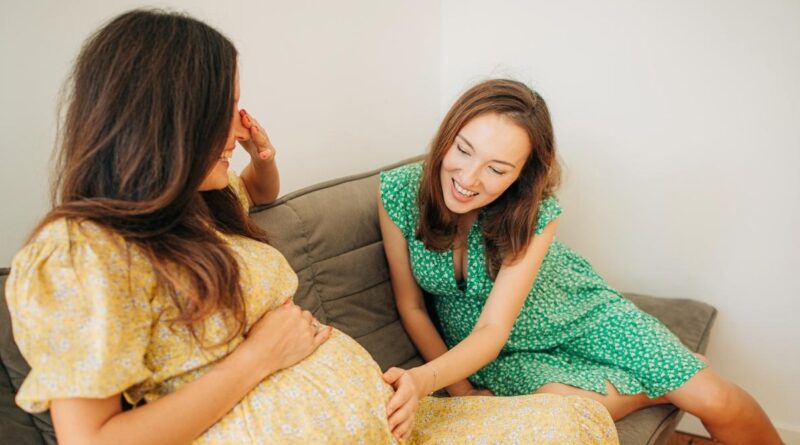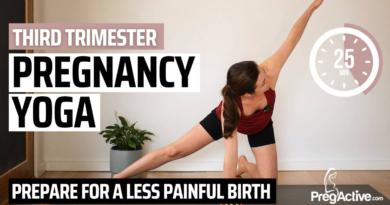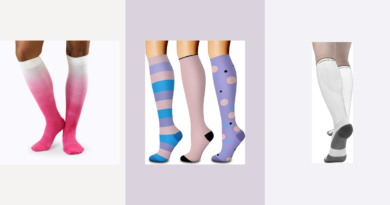Please don’t comment on my bump size, period
A beautiful, healthy-looking baby bump is often among the aesthetic perks of being pregnant. I mean, you could say we deserve it after all the nausea, fatigue and general aches and pains that most of us endure during the first trimester and beyond. But like many things in pregnancy, a textbook bump can’t be taken for granted.
My babies both grew on the smaller side, and one of the things I was hyper aware of throughout my pregnancies was the size of my bump and what it meant for my babies. I desperately wanted the round, uncomfortable-looking bulge that not only looks suitably pregnant, but typically—and reassuringly—implies healthy growth.
I willed my belly to grow, sometimes even pushing it out further to try to capture the physical essence of pregnancy I see so many women carry with pride. But instead, my reality was that in both my pregnancies I grew a small bump that seemed to wobble somewhere between looking like I had overindulged at lunch and appearing weeks earlier in my pregnancy than I actually was. I loved being pregnant, but my small bumps reminded me everyday that there might be something wrong with my baby and I didn’t welcome the visual memo.
The challenges not everyone can see
Growing a small bump was particularly difficult during my first pregnancy because my son tracked along the 1st percentile in utero. Early on, doctors warned me that this much-loved, tiny baby of mine could be stillborn or face challenges associated with growth restriction. As a result, I became increasingly conscious of my own size.
I constantly scrutinized what I could have done wrong to cause my baby’s poor growth on the inside, including berating myself for how my bump looked on the outside. It went far beyond vanity and into a space of fear and anxiety as I contemplated the fate of my pregnancy.
Then the comments started coming in.
Conversations I didn’t want to have
Well-meaning friends who told me my first bump was ‘cute’ made me profoundly uncomfortable.
On more than one occasion these comments segued into difficult conversations I didn’t want to have. Sometimes I would correct them by joking that I wished it wasn’t ‘cute’ (I’d rather have a huge bump covered in stretch marks, thank you very much). At other times I gritted my teeth and graciously thanked them for what I assumed was intended as a compliment that came from a place of love and excitement. Some women want to look cute, sure, and I’d love that too, but not when I’m carrying a potentially unhealthy baby in my little bump.
Equally, some babies grow on the larger side, and this can contribute to bump size too. These women may also feel like they too aren’t providing for their baby adequately enough, with some embarrassed that they’re carrying so large. Imagine how they feel when somebody tells them they must be carrying twins because of their belly size. Probably the same way I did when people implied that I didn’t look pregnant.
When it comes to commenting on other people’s bumps, it’s like society suddenly has a medical degree—but please know that moms just don’t want to hear from you about bump size unless you, well, have a medical degree.
Small bump, small baby
I’d love to say that feedback on size stops with the mother, but it doesn’t. Once my first child was born I enjoyed the typical ‘oohs’ and ‘ahhs’ of adoring onlookers. Yes, my baby is adorable, thank you for noticing (but don’t touch him; he’s still little, by the way).
But when strangers started guessing his age and placing him in the newborn category when he was nearing 3 months, I started to panic. Was there something they knew that I didn’t, or were they just used to seeing babies born in the realm of 7 lbs at full term instead of 2 lbs, 11 oz 8 weeks premature?
People told me my son was ‘dinky’, ‘tiny’, a ‘little dot’. What they didn’t know was that I was obsessed with growth charts and beginning discussions with my son’s pediatrician around high-calorie diets. I was feeling like a failure already; guilty that I couldn’t breastfeed and exhausted from a grueling schedule that demanded strict three-hourly feeds and the logistics that came with it. Bottle feed for 45 minutes, pump for 45 minutes, rinse, repeat. It wasn’t about how he looked, or even what people thought. It was the additional pressure that these unsolicited comments placed on a mom who just couldn’t escape conversations about size.
Related: Dear mama, you’re doing great
Here we go again
During my second pregnancy I worried that I would experience a similar journey to my first. As my first pregnancy was considered high risk, this naturally played on my mind. So too did the size of my second bump.
From the earliest stage, I looked for signs of growth. I ran my hands over my bump, wondering what was going on in there and hoping things would be different this time.
Once again, I had no problem bonding with the baby inside me and I was so grateful for the privilege of pregnancy, but at the same time I was terrified that my bump size represented a red flag. Short of purchasing an ultrasound machine for my house, monitoring my bump by the way it looked and felt seemed to be the easiest, most tangible way I could self-assess the wellbeing of my baby. I was desperate for clues and confidence.
When I started revealing our pregnancy and sharing bump photos, I once again started to attract the familiar anecdotes around my bump size. Here we go again, I thought, as the comments took me right back to where I was three years earlier. I felt triggered because even though things had started off smoother this time around, I was reminded how quickly things can change in any pregnancy.
Eventually, bump two did grow—and so did my baby!—but both would remain on the smaller side. And so the comments continued.
What ‘healthy’ looks like
Knowing your children are healthy is such a beautiful comfort, but not all moms have this insight when they’re carrying them. Without realizing it, public commentary can play on our existing insecurities and make a pregnancy feel that much more complex and fragile.
The truth is that some people just make small babies and carry them in small bumps. Others make large babies and carry them in large bumps.
Neither necessarily implies the health of their baby is compromised. However, if it’s part of a package that comes with medical conversations around having an unhealthily small or large baby, comments around bump size can be particularly hurtful and even damaging. And if the pregnancy is progressing well, comments can still feel judgmental for myriad personal reasons.
How to sensitively talk about bump size
We don’t want to censor discussions around pregnancy to such an extent that friends and family become afraid to comment on a baby bump. What we need is a reminder to be conscious about it. We won’t always know the backstory about a person’s pregnancy, so old-fashioned empathy needs to come into play, no matter how close you are. Remember that this is a woman who is carrying a child—and doing her best to keep them healthy.
Instead of starting a conversation around a woman’s bump size, why not tell her she looks beautiful or comment about what an amazing mom she’s going to be? This can make a pregnant person feel great about themselves, but keep in mind that anything that refers directly to size can be misconstrued, particularly if you’re experiencing a challenging pregnancy.
One of my personal favorites was to hear ‘pregnancy looks good on you’, and comments like that suit women of all bump shapes and sizes.
Like many things in pregnancy, a sweet, textbook bump can’t be taken for granted. But wouldn’t it be nice if kindness and sensitivity could? It’s about being mindful, considerate and respectful. This falls on all of us, whether we’ve stood where they’ve stood or not, because we never know what someone is dealing with in their life—or in their bumps.




